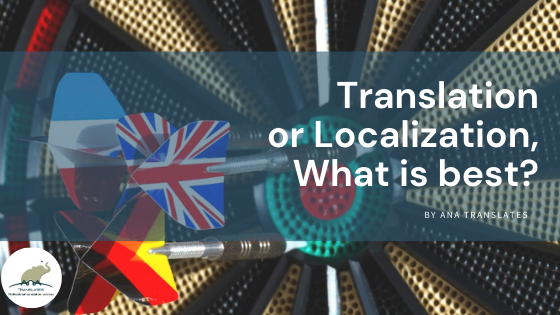Prefer localization if you want to tailor and adapt your content to a specific audience. Choose translation for texts that do not need to be adapted as much
It has often happened to me that when I introduce myself as a translator people are amazed and think I must travel around the globe all the time, meeting new people and attending interesting events…I guess the truth is quite far from this, they seem to be thinking of an [before-COVID] interpreter instead of a translator. As a translator, I mostly work from home on my computer and don’t need to travel much for work.
I guess this happens because the profession, as noble as it is, tends to be quite unnoticeable too. Which, don’t get me wrong, is not entirely bad as it usually means that you are doing a good job and therefore it is almost invisible. I do not intend to get too philosophical or technical here, yes, as translators we do have a voice and we do make choices in the way work, but it is discrete labor.
Either individual clients or companies usually do not know much about translations services until they need them. When that happens, they are bombarded with different terminologies: translation, localization, transcreation, globalization, and more. What I intend to do here is explain the main differences between localization and translation services (most common) and when to choose one or the other.
Simply put, translation is the transfer of meaning from one language to another; from one source text in a source language to a target text in a given target language. Following this logic, interpretation is a type of oral translation.
There are many strategies and theories on how a translation should be done. Some suggest translations should be literal, strictly following all syntax and vocabulary choices made by the original writer. Others suggest a ‘free’ translation style, one that allows the translator to reconfigure certain grammatical structures or make vocabulary choices that better suit the target language’s conventions.
Nowadays, with the internet and all globalized platforms and products, translations tend not to be enough. Companies and businesses are targeting clients in specific regions and countries, and therefore want to adapt their text to their particular location. For example, your client would ‘rent’ a car in Mississippi and ‘hire’ one in London; live in a ‘flat’ in Liverpool and in an ‘apartment’ in New York. These simple nuances make huge differences, and here is where localization starts playing a significant role in translation studies and the professional field.
Localization also considers culture. Differently from translation, it can substitute inappropriate cultural symbols for some more adequate to the target culture. This is particularly useful in a marketing campaign, where you are targeting different cultures and locales. It is important to keep in mind that languages differ not only from country to country but from state to state and from city to city.
In my previous post, I talked a bit about the benefits of translating your website, and how to decide into which languages it is worth translating it into. Now, a different question arises: translation or localization? It all depends on the type of text you are translating and its purpose. Translation is useful when you need to ‘rewrite’ in another language texts where the message is the most relevant. Some examples are informative texts such as user manuals, official documents, medical or scientific publications, internal communications materials, and more. [see footnote]
Localization, on the other hand, is useful when you want to adapt your material to another country, and aesthetics and style are a key part of the message itself. This is the reason why localization is preferred for websites, apps, games, multimedia content, and even certain marketing campaigns, as it should also consider images and multimedia. Let’s say, for example, that you are launching your new video game in Spain and Mexico, and you want to include a youthful expression indicating excitement. In Spain, you would probably say ‘¡Que guay!’ while in Mexico you would rather use the expression ‘¡Que chido!’ Both mean the same and would likely be equally understood, but one would feel more familiar than the other.
Check out our Social Media posts to see more examples, and feel free to add some more!
To check the services we offer to businesses and institutions click here!


